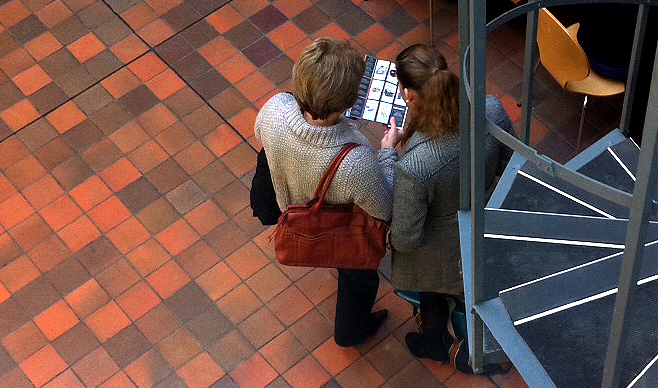1.
Evans, M.A., and Pei, E., (2010) "ID Cards". Loughborough
University, ISBN: 978 1 907382 35 2.
ID Cards are one of
the outcomes from a Loughborough Design School PhD undertaken by
Dr Eujin Pei and supervised by Dr Mark Evans and Dr Ian
Campbell. The aim of the research was to improve collaboration
between industrial/product designers and engineering designers
during New Product Development. Literature review, action research, surveys and
observations were used to collect data during the development of
the ID Cards. A central feature of the research methodology was
a high degree of global engagement with educators and
practitioners, with support being received from leading
universities, consultancies and manufacturers. Research findings
indicated a need to facilitate greater understanding of the
language and methods used by industrial/product designers and
engineering designers. The key design representations employed
during New Product Development were identified and surveys
undertaken to establish when they were used and for what types
of information. This generated large amounts of data that was
converted into a playing card based tool for use by designers.
ID Cards have translated and modified key elements of the 114
double-side cards into a more portable
and
accessible format to support the education and practice of
designers at all levels. The ID Cards are now available as a
Z-card folded media in pocket size (16 December 2010).

(Above) The ID Cards
were distributed to students as a reference for learning.
Further Reading
1. Eujin Pei (2009) "Building a
Common Language of Design Representations for
Industrial Designers & Engineering Designers".
PhD Thesis, Department of Design and Technology,
Loughborough University, United Kingdom
To
achieve success in today’s competitive environment,
companies are realising the importance of design
collaboration during new product development. The
aim of this research was to develop a collaborative
design tool for use by industrial designers and
engineering designers. To achieve this, a literature
review was undertaken to understand the working
relationship among the two disciplines during new
product development. Following this, empirical
research through interviews and observations
outlined three problem areas: conflicts in values
and principles; differences in education; and
differences in representational tools and methods.
The latter was chosen because the problem area of
design representations was found to be highly
significant. In looking at bridging differences in
design representations, a taxonomy comprising 35
forms of sketches, drawings, models and prototypes
was generated. A second stage of empirical research
was conducted to establish the popularity of each
representation and the type of design / technical
information that industrial designers and
engineering designers communicated with. The
information was indexed into ‘CoLab’ cards that
would enable the two disciplines to gain joint
understanding and create shared knowledge when using
visual design representations. Following a pilot
evaluation and minor modifications, student and
practitioner interviews with a case study were
employed to assess the significance of CoLab. The
findings revealed that a majority of the
interviewees felt that the tool had built a common
ground through having a common understanding in use
of visual design representations.
2. Eujin Pei, R. I. Campbell and M. A. Evans
(2011) "A Taxonomic Classification of Visual Design
Representations Used by Industrial Designers and Engineering
Designers" The Design Journal, 14 (1): 64-91
In the context of
new product development (NPD), research has shown that not
having a common understanding of visual design representations (VDRs)
has affected collaboration between industrial designers and
engineering designers when working together. The aim of the
research presented in this paper was two-fold. Firstly, to
identify the representations employed by industrial designers
and engineering designers during NPD from a literature survey.
Secondly, to define and categorize these representations
in the form of a taxonomy that is a systematic organization of
VDRs that are presently dispersed in the literature. For the
development of the taxonomy, four measures encompassing
orthogonality, spanning, completeness and usability were
employed. It resulted in four groups consisting of sketches,
drawings, models and prototypes. Validation was undertaken by
means of an interview survey and further, presenting the
taxonomy at an international conference. The results showed that
no issues were raised by the respondents concerning the
structure of the taxonomy or its components. // Keywords: visual
design representations, industrial design, engineering design
3. Eujin
Pei, R. I. Campbell and M. A. Evans
(2010) “Development of a tool for building shared
representations among industrial designers and engineering
designers” CoDesign, 6 (3): 139
- 166, ISSN 1571-0882.
Previous studies have demonstrated the importance of
multi-disciplinary collaboration in New Product Development (NPD).
As such, interactions between industrial designers and
engineering designers have become increasingly important. This
research project aims to build a shared understanding between
the two disciplines during NPD. Following empirical research
that revealed collaboration-related problem areas, as well as
collecting data concerning the use of design representations, a
card system was developed to provide information on the role and
significance of design representations, leading to joint
understanding, improved communication and creation of shared
knowledge. When asked in the validation study if the system
would foster collaboration, 68.2% of industrial designers and
63.2% of the engineering designers gave a good and excellent
rating, indicating that the system could play a significant role
towards the support of multi-disciplinary teamwork. // Keywords:
collaboration; design representation; industrial design;
engineering design; new product development; product design
Send an Email to request
more information
Next Link: Concept Design
